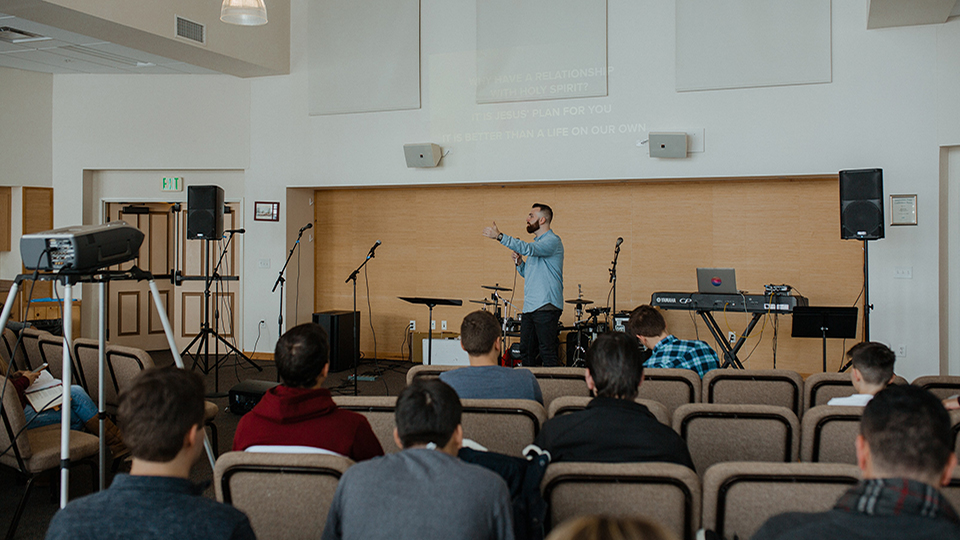
Ministry practices are facing a great challenge during this time of uncertainty. One thing that has remained certain is that students need to hear the hope of the Gospel, be discipled, and experience Christian community. Dr. Garland Owensby, Southwestern Assemblies of God University (SAGU) Youth & Student Ministries Coordinator, spent time communicating with some SAGU Youth & Student Ministries alumni about how they are interacting and ministering to students during this time.

Like many of you, I have been working from home when I would normally be meeting face to face with my students. Many churches have transitioned to online services on a variety of platforms. What to do with youth ministries has been a little more of a challenge. The in-person experience is such a strong component of student ministry because students thrive on community, friendships, and social interactions. In response to the stay-at-home orders given by many states, Psychology Today writer Christine L. Carter wrote, “Teenagers and college students have amplified innate, developmental motivations that make them hard to isolate at home. The hormonal changes that come with puberty conspire with adolescent social dynamics to make them highly attuned to social status and peer group” ( How to Help Teens Shelter in Place ). Taking away school, church, hang-outs, and parties has created a problem for adolescents. According to a survey conducted by Medium.com , 40% of students reported feeling disconnected.
I recently made contact with some alumni working with student ministries to ask how they are ministering to students during these challenging times.
Q: How are you maintaining a connection with your students?
 David Hankins, Angleton First Assembly of God , Angleton, TX
David Hankins, Angleton First Assembly of God , Angleton, TX
Insta: @belongym
FaceTime calls seem to be huge. I have middle school students who can’t get enough of them. I am trying to take one day out of each week to go and do a drive-by hello. I’ll take a couple of lawn chairs, set them up 6 feet apart in their yard, and text them to come outside. We’ll talk for maybe 5-10 minutes before I move on to the next kid. TikTok is big right now, so I try to do a minute-long verse-of-the-day devotional. I’ll save that video, and post to both Snapchat and Instagram so all my bases are covered. I also use all platforms to do games and contests throughout the week for $5 prizes that are mailed to the winner.
 Tyler Peterson, Crossroads Victory , Montrose, Colorado
Tyler Peterson, Crossroads Victory , Montrose, Colorado
Insta: @unshakablestudentministries
The way that we are really working to maintain the connections with our students is by giving our leaders different students’ contact information so that they can stay personally in touch with them during this time away. We are also incorporating games like Kahoot, movie nights and Zoom discipleship to help us continue to build these connections. Instagram has been one of our biggest touch points because that is the social media service the vast majority of our students use. The way I view social media right now is as a tool that we can use to help us reach out and stay in contact with our students as well as a platform for us to spread hope and continue to be a light to our community. This is why I tag a lot of our students in our posts on Instagram because then their friends will be able to see it as well.
 Daytrian Henson, Victory Family Church , Burleson, TX
Daytrian Henson, Victory Family Church , Burleson, TX
Insta: @ vym_burleson
A few things I am doing is having small groups on Mondays and Tuesdays on Zoom, having Zoom call lunches, and texting or calling them just to check up on them. I have been using Twitch because some of my students actually stream games.
 Dustin Wilson, Grace Community , Flower Mound, TX
Dustin Wilson, Grace Community , Flower Mound, TX
Insta: @onestudentsfm
We are maintaining contact with our students by utilizing every social media platform and technology imaginable. When church services began to cancel due to the virus, we had to cancel our spring break activities. In response, we would host Instagram live Q&A’s with our students. Those were fun the first week and a half. When attendance started to struggle, we switched over to Zoom. This platform worked well because we could see everyone. We are working to schedule an Illusionist for the weeks to come thanks to Kyle and Youth Alive . We have been calling our church family throughout the week also. FaceTime, texting, and phone calls have been a big win.
 Tyler Harris, Albuquerque, New Mexico
Tyler Harris, Albuquerque, New Mexico
Insta: @harvestabq_youth
The keyword is “engage”. We’ve always used social media as a “bulletin board” for our announcements, but this has changed our intention to trying to engage them, call students to action, even if that action is, “vote for what movie we’re going to watch this Friday!” We’ve always used Instagram and text messages to connect, so we ramped those up to be more present. We started using YouTube almost daily, posting videos, messages, encouragement, worship, and skits. We’re using Discord to chat in text and audibly in their voice chat. After each online service, we play video games together, mostly JackBox. We’ve tried Twitch, but we’ve been most successful with Zoom calls, screensharing the game and playing on their phones. Instagram Live has been hugely successful and we used Netflix Party this past week for the first time to watch the all-time classic Nacho Libre together. So, we’re chatting all the way through the movie. My students seem to love talking in chat.
.jpg)
Luke Standage, The Power Place , Kennett Square, PA
Insta: @powerplacestudents
The biggest thing our Student Ministry is trying to do is be present. We’ve started doing a Daily Devo time at 12:30 PM every day on Instagram Live. In this Devo time, we are going through a devotional plan that I’ve encouraged all of our students to go through with us on the YouVersion Bible app. It’s been really cool to see all the students’ responses in the Bible app after their daily reading. Instagram has been our main use of social media connection for our students because it is the biggest platform our students use so that’s where we’ve tried to focus our attention. One thing I’ve really enjoyed is during our Daily Devo Times I bring on one of our Student Leaders on the Live with me. When they go Live with me it notifies me of the users that went live, so we are gaining access to so many new students that don’t even follow our account. One of the days, there were at least 15 of the Student Leaders’ friends on with us.
“After the call, the student was so excited. He told me ‘most of those friends would never walk into a church building with him but were able to hear truth online.'”
Q: What does your youth service look like now? How has it changed or adapted?

We use two different platforms for our midweek service: Instagram Live and Zoom. I’ll allow the first 10-15 minutes to be conversational, asking how everyone’s doing and such. The final 25-35 minutes are devoted to the lesson. Even though I’m doing it from home, I’m still sticking with the year-long series we started in January.

So right now our service has changed quite a bit. Instead of having a traditional setup with worship, games/activities, a message, and breakout sessions, we have gone to more of a coffee talk style, quick message, and then interactive questions to try and get our students to interact. With the use of Instagram, we have been able to pull in students and leaders to our services and ask questions and give them challenges to win prizes and points for our ongoing competition.

Right now, I am recording a message and posting it on Instagram and Facebook, but I want to have a set schedule for the week and doing a YouTube/Instagram live video!

Youth Service is different now. We try to keep our sermons short, as well as our worship set. We do run into some copyright issues be we did purchase the license to stream. We open with a welcome, encourage others to share and like our page. We then play a short video, move into a worship song, and have our sermon. After the message, we have a short song, and then a quarantine from home video. Our service time is about 30 minutes on Wednesdays, and even that may be a bit too long. There are lots of benefits to it though, we do reach a bigger audience. We have had over 100 views on our service week. Students do watch it, but also aunts, and uncles, friends and family tune in as well.

Our primary youth service takes place on Sunday nights at 5 PM on YouTube. We pre-record 30-45 minutes’ worth of footage the week leading up, five to six videos, put it all together in a single video, and premiere it on YouTube. During the video, we’re in chat-talking, commenting on the video, mostly just making jokes.
.jpg)
My wife and I bring a short sermon from our living room on Instagram Live. Then we have different Zoom calls for our various small groups. There’s a feature through Zoom where we can all join the same Zoom Group initially for a big group game and then split up into our Small Groups for discussion questions and prayer.
Q: What has been the response?

The response has been great! I think out of 35-40 students, 30 have been regularly showing up online, and the remaining kids catch the service on replay.

My response has been to really put aside what I feel youth ministry is supposed to be like and adapt/be flexible to where it needs to be with the way the world is right now. We can’t get upset that we can’t do things the exact same way we always have, but we have to be flexible to look at this as an opportunity to grow and reevaluate not only ourselves, but the way that we do ministry, and become more effective.

The students love our Zoom calls. Even if it is just us hanging out, they love the opportunity to be with friends and not have to really stress about what’s going on in the world.

The students have been tuning in, but they pick and choose the day and time. Students have been enjoying Zoom, but we have had a different crowd each time. Parents and families have been sharing and they are appreciative of what we have been doing.

If you compare our attendance when in-person to our attendance during our Sunday Youth Online, it looks like it’s higher than our in-person service. I actually hear MORE from my parents about their thoughts or their student’s thoughts on the service.
.jpg)
We have had really good participation from our Students for our services. I think the biggest key has been our leaders and small group leaders texting our students to make sure they are part of the night.
Q: What has been the most challenging?

Most challenging for us has been consistently reaching students. When we would have events and things at set times, it was easy for our students to schedule the time that they would come and spend with us, but with the change that is going on, we are all readjusting. I am working on a schedule of events that will go on every week, so that way our students can look forward to and anticipate those times and being connected with us.

Initially, learning to live stream was a challenge. We were able to work the kinks out until we moved into working more with the premiere feature. A major difficulty is that people pick and choose when they tune in. It is easy to pop out of the video to watch something else and then tune back in. It is also a common occurrence for people to watch it at a later time. With that said, the content is available and ready to watch whenever. Our follow-up Zoom calls on Thursday helped to provide some accountability. Technology can be a challenge when it does not work properly. We had to cancel one Livestream because Instagram refused to work properly. Zoom has worked much better, but we are sure to share the ID and passcode only to trusted individuals. We have not been broadcasting that info on social media.

It is actually a lot more work to prepare the content than prep for an in-person service. I work more hours now than I did before to prepare for less content. Probably because so much of this content has a much longer shelf life than just my in-person Sunday. If my game bombs on an in-person Sunday, most students can forgive and forget by the time we do something that’s actually good. Online, if we have an off week, it lives in video form forever.
.jpg)
The most challenging aspect has simply been just not being together. Also, the feeling of losing momentum. We had a group of students that had just started coming that we are trying to maintain during this time. I think it’s hard to stay connected with those fringe students as well through all of this.
Q: What questions appear to be on the minds of your students right now?

My kids all are a little anxious about what everything will look like once the dust settles. What’s the new normal going to be, or is this it? How can they stay active in their faith when their pastor isn’t able to do what he normally does as far as pushing and challenging goes?

I think a lot of our students are really thinking about their families, and the question would be, “will my family be okay through all of this?” A lot of our students come from families that live paycheck to paycheck, or pretty close to that, and so for them, I know that there is a lot of concern for just the well-being of their family. This is why we have put out there to our students and to their families as well, that we are here to help, through our church’s food pantry, helping with childcare if parents need to go to the store, etc. We want to continue to be a resource for our students and their families even through this trying time.

When is this all going to end? Will my parents ever get their jobs back? What’s going to happen to my last year of high school?

Students primarily have been asking what to do during this time. They have been asking what we have been up to. They are looking to discover the norm in today’s crisis. They miss their sports! They are adjusting to school online. In a strange way, I think they are more prepared for this time than most adults. They understand technology more than what I ever could. We are all doing our best in this ever-changing world and virus scare. Some things work and some things don’t, I am just thankful that all of our pastors are trying their best. We are also building a huge online resource without realizing it. We also have a great district that are producing great resources as well. The Gospel is still being preached, and it may be going farther than we realize around the world.

Our students are very concerned with the tangible – what’s right in front of them. So school, their friends graduating, their graduation, prom, youth camp, and having to live in their house nonstop with their siblings and parents. Tensions are high and grace is low after a few weeks of living together in quarantine.
.jpg)
The biggest question I hear is… Where is God in all of this?
Want more ThoughtHub content?
Join the 3000+ people who receive our newsletter.
*ThoughtHub is provided by SAGU, a private Christian university offering more than 60 Christ-centered academic programs – associates, bachelor’s and master’s and doctorate degrees in liberal arts and bible and church ministries.



